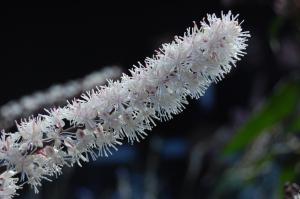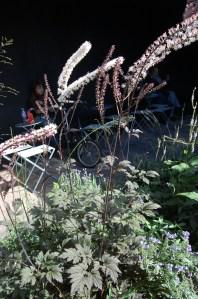
Actaea racemosa 'James Compton' flower (17/09/2011, London)
Position: Full sun to shade
Flowering period: Late Summer
Soil: Well drained soils
Eventual Height: 1.5m
Eventual Spread: 0.5m
Hardiness: USDA Zones 5a-9a
Family: Ranunculaceae
Actaea racemosa ‘James Compton’ is a herbaceous perennial that grows up to 1.5m in height. The basal leaves are up to 1m long and broad forming repeated sets of 3 leaflets bearing coarsely toothed margins. The foliage changes through the season with the compound leaves changing from green to to a dark purple black in late summer. The flowers are produced in late summer on a tall stem. They are sweetly fragrant and white in colour with a slight tinge of pink. They are 75-250 cm tall and have no petals or sepals and consist of tight clusters of long stamens surrounding a white stigma. The fruit is a dry follicle 5-10 mm long containing several seeds and one carpel. The roots of this plant grow from an underground rhizome. The form ‘James Compton’ has dark bronze leaves and is the most fragrant variety.
The species Actaea racemosa, commonly known as Black Snakeroot, Black Bugbane, Black Cohosh and Fairy Candle, is synonymous with Cimicifuga racemosa. It is native to eastern North America from the extreme south of Ontario to central Georgia and west to Missouri and Arkansas. It is often found in woodland habitats mainly in the small woodland openings. This plant was used by Native Americans to treat sore throats, kidney problems and depression. The plant appeared in U.S Pharmacopoeia in 1830 under the name Black Snakeroot. Today the plant is used as a dietary supplement marketed towards women suffering from menopause or premenstrual tension. This plant was introduced into the UK in 1732 by John Bartram.
The name Actaea is derived from the Greek Actaia, which means Elder, as the leaves of this plant resembling those of this tree. Racemosa is derived from the Latin meaning flowers in racemes.

Actaea racemosa 'James Compton' (17/09/2011, London)
The landscape architect may find Actaea racemosa ‘James Compton’ useful as part of a woodland planting scheme. Due to this plant’s architectural habit it can be used to add an accent to a herbaceous planting scheme.
Ecologically, A. racemosa ‘James Compton’ is attractive to flies, beetles, bees, birds and gnats due to its fetid smell.
A. racemosa ‘James Compton’ prefers soil with a PH of 6.6 to 7.5. It likes moist soil so long as its well drained and dislikes boggy conditions. It can be alkaline, neutral or acidic.
The Royal Horticultural Society has given the species A. racemosa their prestigious Award of Garden Merit in 1993.
A. racemosa ‘James Compton’ requires little to no maintenance. It may be cut back in late autumn after flowering and fruiting. Established plants may be divided in spring.

